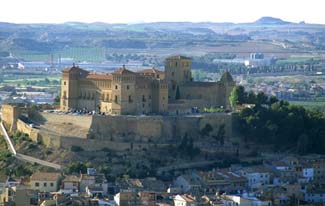
Photos courtesy of Parador de Alcañiz
Castillo Calatravos, s/n
44600 Alcañiz (Teruel)
Tel: ++34 978 83 04 00
Fax: ++34 978 83 03 66
Official parador website
Reserve with Booking.com
35 rooms
Double rooms: 95–295 euros
Single rooms: 80% price of a
double room
Rates include tax. Breakfast
extra.
Free Wi-Fi
Open: mid-February through first week of January
Alcañiz lies in the eastern part of Aragón, 105 km southeast of Zaragoza on N-232. The parador is on the hill in the middle of town. Follow the signposts. Bus and train transportation is available to Alcañiz, but the going can be very slow.
On site: sauna
Nearby: hiking; swimming;
canoeing
Two huge, imposing square towers flank each side of this castle’s façade. The parador sits unassumingly off to one side.
The castle ambiance is carried throughout the public rooms, where Aragonese heraldic banners hang from thick stone walls. Leather couches and chairs sit on woven throw rugs in front of a big fireplace, inviting cozy repose during the brutally cold winters. A small cloister holding several sarcophagi of the knights of the Order of Calatrava is open for viewing.
An enormous stone stairway leads to spacious guest rooms decorated in warm tones with heavy brocade drapes, and throw rugs atop red tile floors. One room has a canopied bed. Small windows overlook the steep streets of the town; one corner room has especially fine views.
The inviting dining room is decorated with the coat of arms of several knights of Calatrava. Overhead, wrought-iron chandeliers hang from a wood-beamed ceiling, and an impressive stone fireplace anchors one end of the room.
![]() Don't miss the Plateresque sepulcher and the Gothic murals.
Don't miss the Plateresque sepulcher and the Gothic murals.